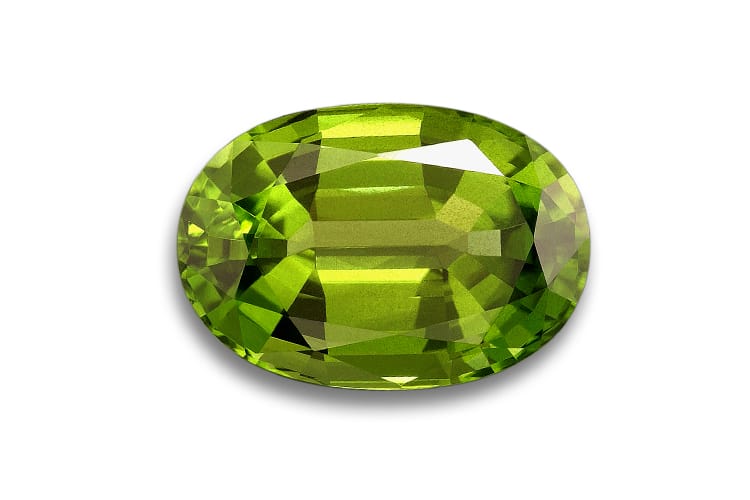Guide to Peridot

History, Lore and Appreciation
For anyone who loves hazy, yellowish green colors, peridot is sure to be appreciated. At its best, the gem exudes a soft, oily appearance; comparable to the deep greens you might see in olive oil.
In ancient times, peridot was described as a gem “containing rays of sunshine.” It is easy to see why: in direct, brilliant sunshine, peridot often returns a warm, yellowish glow to the eyes. Additionally, peridot has very high double refraction causing an optical effect in which a doubling of pavilion facets often is observed when looking through the table of the gem; this feature accentuates peridot’s soft, velvety look.
Peridot is a variety of olivine and it has been treasured as a gem for thousands of years. Egyptian slaves are said to have discovered the first source for it at Zabargad, a desolate island in the Red Sea (today’s St. John Island). Zabargad is considered the classic source for the gem, though it no longer produces commercial quantities. Luckily, the mineral olivine occurs on every continent. As a transparent, bright green gem, peridot is much more elusive. Interestingly, Peridot has been found in a particular type of meteorites, a pallasite from Argentina, from which small (up to 1 carat) stones have been cut for collectors that prize them as an extra-terrestrial gem.
The origin of the name is thought to be Arabic, deriving from the word faridat, meaning gem. However, French and 13th Century English root words have also been suggested as the name derivation for this gemstone.
Birthstones and Anniversaries
Peridot is one of the birthstones for August. It is also a 15th wedding anniversary gemstone.
Description and Properties
Peridot is an olivine, a solid solution between the minerals forsterite and fayalite that crystallizes in the orthorhombic system and has the following chemical composition: (Mg,Fe)2SiO4
Colors: yellowish green to greenish yellow to brownish green
Refractive Index: 1.65 to 1.69 (±.020) Birefringence: 0.035 to 0.038 Specific Gravity: 3.34 (+0.14, -0.07)
Cause(s) of color: traces of iron and magnesium, and in some gems chromium may be present.
Mohs Hardness: 6.5 to 7
Internal identifying characteristics: Inclusions of biotite mica, chromite and biotite in the gem often cause internal stresses to occur. In turn, these stresses cause liquid filled discoid fractures known as lily pad inclusions.
Treatments
None known.
Collector Quality
With peridot, locality, color and size are the significant aspects to consider. Gems that can be proven to come from Zabargad are rare since that classic deposit has been largely depleted. Myanmar (Burma) and, more recently, Pakistan are sources that continue to provide exceptional gems of significant size, and exceptional color, often over ten carats.
Because peridot is plentiful, collectors often opt for size (ten carats or above) with saturated, slightly yellowish
green colors. Cut has become an important factor: well-balanced gems that efficiently return color and light, together with crisp facet junctions, are always appreciated. On extremely rare occasions, a star peridot (sporting 4 rays) is reported.
Localities
Egypt (St John’s Island) is the classic source, though it is no longer a commercial producer of the gem. Myanmar (Burma) is considered a classic source too, if only because it has consistently produced large, clean peridots, which have become a global gauge to measure this gemstone’s beauty. In recent years, Pakistan has also become a producer of very fine material. The United States consistently mines for the gem in Arizona, though they are generally smaller and sometimes slightly brownish in color. Australia, Brazil, China, Kenya, Ethiopia, Norway, Sri Lanka, Finland, Tanzania, Vietnam, and the Antarctic have also produced it, though not in significant commercial quantities.
Cutting, Care and Cleaning
Because peridot is not an extremely hard gem, ultrasonic cleaners are not an ideal way to clean peridot jewelry. Peridot is also susceptible to extreme heat, so steamers should not be used. Certain acids used in jewelry manufacturing may etch peridot, so it is recommended they not be used around this gem. Finally, a soft, damp cloth, or a soft bristle toothbrush is probably best to use when cleaning peridot jewelry.
Source: CIBJO Retailer Reference Guide, cibjo.org.